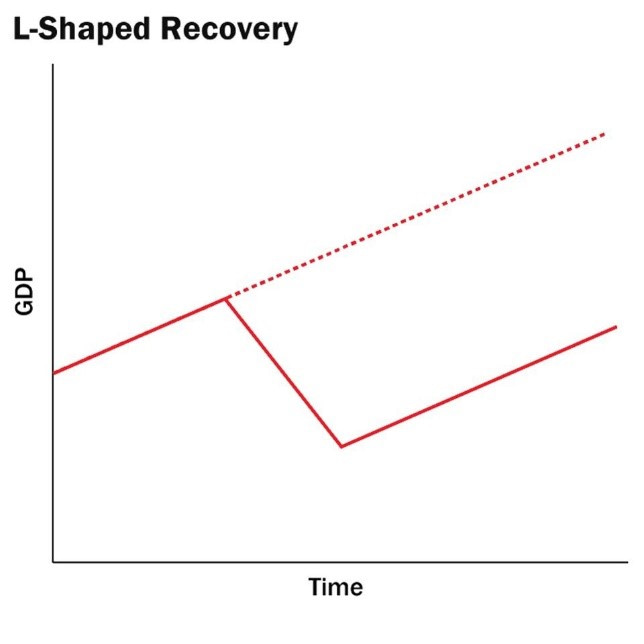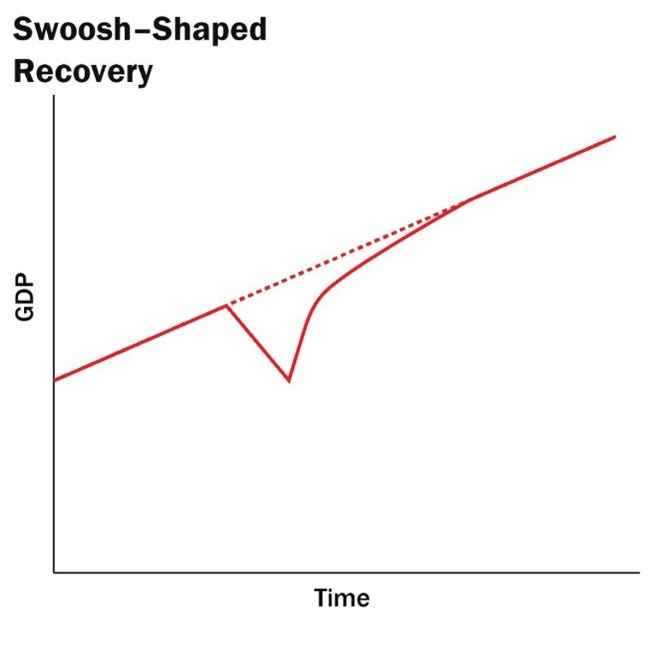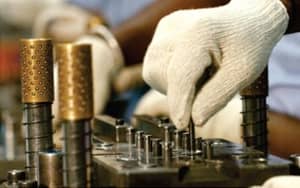If there’s one thing every investor has an opinion about, it’s what shape the economic recovery will take. So, what is ‘shape?’
An economy goes into recession when it reaches a peak of activity and ends when the economy reaches its trough. At that point, the recovery begins.
When economists plot out an economy’s future path, most often in terms of GDP, the shape of the graph is used to describe the recession and recovery cycle after a crisis such as the coronavirus pandemic we’re dealing with today. And this information is used by advisory firms such as HCR Wealth Advisors in counseling their clients.
Economists typically refer to V, U, W, and L shapes. But this recession is different. The intense interest by the general population and the media on the pandemic’s impact has led to nuanced options as well: the Nike swoosh, or the reverse swoosh. The square-root symbol. And this week, Bloomberg announced that the French economy’s recovery might look more “like a bird wing.”
The National Bureau of Economic Research did not wait for the typical two quarters of soft numbers to formally declare the U.S. economy to be in a recession. In early June 2020, it wrote that “a peak in monthly economic activity occurred in the U.S. economy in February 2020.”
And that, “… the unprecedented magnitude of the decline in employment and production, and its broad reach across the entire economy, warrants the designation of this episode as a recession, even if it turns out to be briefer than earlier contractions.”
Lastly, that, “the pandemic and the public health response have resulted in a downturn with different characteristics and dynamics than prior recessions
There’s no doubt that the shape of the recovery will touch everyone, not just investors; it determines how quickly – or slowly – the economy rebounds after the dramatic losses in February and March 2020.
As usual, financial and investment advisors like HCR hear two questions during any recession: “When will it end?” and “How fast will the economy recover?”
Let’s look at all the more likely ‘shape’ options, including what factors might drive them and experts who support each forecasted shape. With this information, as we go forward, we’ll be able to watch market indicators and better interpret what the future might hold.
The V

Photo by Isaac Smith on Unsplash
A V-shape recovery is possible when you have a steep fall – as we had with this pandemic and its forced global shutdowns. Then you need for the economy to hit bottom and bounce back to where it started, partly thanks to pent-up demand. Ideally, it will then continue as if nothing had happened.
It’s the most optimistic scenario and the one everyone hopes for. But, being the best-case scenario, it is also the one most likely to suffer from glitches. The shutdown could not have caused any material damage to the economy, or upside forces will have to neutralize the impact of any damage.
Even this early, HCR Wealth Advisors’ clients are asking what trade will look like if trading partners’ economies are slow to pick up. What will the travel industry look like post-pandemic? How much confidence will have been eroded in the innate safety of such travel? What about all the small businesses that will never reopen because they couldn’t hold on long enough or survive in the new configuration of doing business?
And, most vital: will there be a second wave dangerous enough to cause a second shutdown? Or are the ‘hotspots’ we see during the reopening just that: momentary flares?
We’ve witnessed V-shaped recoveries before, such as the recessions of 1990-1991 and 2001. Both only lasted around eight months. Neither was as pervasive as this one, but they didn’t follow as strong an economy as this one did either.
Various large firms such as Credit Suisse, Morgan Stanley, and Goldman Sachs see a possible V-shape to the recovery. As they watch the economy reopen, they see equity markets rising, substantial jobs numbers being reported, and an unrivaled policy response from Washington, D.C.
Others, such as Deutsche Bank, think it is too early to take a victory lap. They, too, see a robust initial bounce for the next three months, but question what things will look like six months out.
Many economists feel that a solid V-shaped recovery can only hold if either a vaccine or an effective treatment is massively available against the coronavirus. And that adds two questions: if and when.
The U

Photo by Isaac Smith on Unsplash
After the V, the U-shaped recovery is the next most desired. The decline may be slightly gentler than that of a V. But, instead of bouncing back sharply from the bottom, the U recovery pattern takes a slower turn, lingering longer near the bottom as it looks for push-off support.
A U-shaped recovery occurred between 1971 and 1978. Frustratingly, both inflation and unemployment remained high throughout those years.
The senior economist at UBS Global Wealth Management says they are expecting a U and not a V. The concern is the depth from which the recovery is starting. Even the remarkable numbers being reported recently for job growth and retail sales are not enough to avoid a slower, rounder return.
HSBC analysts predict a modified U worldwide. They don’t see that the downslope (the massive job losses and number of shuttered businesses in March and April) will likely worsen. But they do see a delayed rebound with a jagged bottom as governments provide rounds of fiscal stimulus to shore up and restart their economies. The delay may come from two places: a slow return to work by people whose jobs have disappeared with businesses that closed for good, and resistance by consumers to go back to old spending patterns for fear of catching the virus before a vaccine is available.
The W

Photo by Isaac Smith on Unsplash
A W-shaped recovery is probably the most dangerous for investors. After a downward movement, a bounce occurs, which investors assume to be an optimistic V. Many will buy into the markets to take advantage of lowered pricing, and then get caught if the markets take a second tumble. That second fall could come, for example, from a premature reopening of markets and a subsequent need to re-impose restrictions and shut down some or all activity to rein in the virus. Whether it’s the result of another event or the fact that the stock markets simply can’t support the first bounce, the economy can fall and form a double-dip recession.
In a W recovery, the first mini-V-shaped move is known as a “bear market rally.” This is what many called the rapid rise of the U.S. markets in May. Skeptics see a double-dip such as the U.S. experienced in 1979. In 1980 and 1981, two back-to-back recessions followed the inflation and oil crises of the late 1970s.
The L

Photo by Isaac Smith on Unsplash
The most discouraging of the economic recovery shapes is the L. From a deep drop, the economy recovers a certain amount, but never reaches the levels from before the fall. The recession may end, but the economy “just sits there,” taking years to reach its earlier level of economic output.
This pattern was seen after the Great Recession of 2008-2009, where, despite the fiscal stimulus of the Obama Administration and the Fed’s efforts, the Brookings Institute reports it took six years for the per-capita GDP to get back to 2007 levels. This quick-fall-and-failed-recovery also resulted in Japan’s ‘lost decade’ in the 1990s.
Before the excellent May jobs report (2.5 million new jobs and unemployment down to 13.1%), many thought the U.S. could be headed towards an L-shaped recovery. Some experts feared that the lost investment and momentum would never be recaptured, and that slow productivity growth would hold the economy back. People saw risks in the shifting relationship with China – including changes to the global value chain — and feared permanent changes to fiscal policy.
The exotics

Photo by Isaac Smith on Unsplash
A checkmark, or tick-shape, is also called the “Nike swoosh.” A steep drop is followed by a recovery that starts sharply, then takes longer than expected, possibly because of an excess of caution. (Caution in investing, spending, traveling, eating out, attending events and so forth.)
Chief economist Mark Zandi at Moody’s feels the recession’s trough may have ended in May, even if not announced officially. Yet he sees sufficient structural damage to the economy to possibly turn a V into a Nike swoosh. Still, not a W. But he does expect some sideways movement after initial state reopenings unless a viable vaccine or therapy can support the needed growth. To Zandi, the major risks are the second wave of coronavirus or the lack of further fiscal rescue packages out of Washington to support jobs and growth.
The pattern could look more like a square-root sign in cases where the swoosh plateaus before reaching pre-pandemic economic levels. This shape has many supporters who feel the economy will take many years to reach acceptable unemployment and GDP levels.
A U.S. economist at Deutsche Bank sees the Federal Reserve reflecting a high level of uncertainty in the economic outlook. However, the Fed has shifted from a ‘triage’ phase to a recovery phase in its policies. The May jobs report may have pulled positive results forward from the expected timing of July, but too many disruptions exist going forward not to remain cautious.
As an aside, the bird’s wing is the latest addition to recovery shapes. France’s central bank governor, François Villeroy de Galhau, reports that the country’s output did not fall as much as expected during the lockdown. And its consumer spending has returned faster than expected, although its rate is expected to lessen. All told, Villeroy feels the recovery will form a ‘half-V’ or a bird’s wing.
So, should you pick a shape as an investment strategy?
Each described recovery shape brings with it a high level of uncertainty, mostly revolving around future events over which we have no control. From jobs to trade, from global supply lines to fiscal stimuli, and from a weak or strong second wave of the virus.
HCR Wealth Advisors is a firm that does not doubt that the economy will eventually recuperate. The fundamentals are strong, and U.S. capital markets are still intact. The firm enjoys an experienced, well-trained team and the ability to productively help clients.
The question is when. Also, the fundamental question to ask is where a client is in their life cycle and how long can they wait to recover from losses, should they occur. A well-designed retirement plan with a wealth management firm like HCR Wealth Advisors can help to ensure that assets are protected and that clients are positioned to benefit from whatever timeframe plays out in the recovery. (Whatever letter or symbol it looks like.)
About HCR Wealth Advisors – HCR Wealth Advisors employs its innovative financial management framework, The Clarity Formula™, to guide you through times of prosperity and uncertainty. Despite market unknowns as we are experiencing now, HCR can help clients reach financial freedom with the perspective and insight needed to move them forward with confidence.
This article is provided for informational purposes only and should not be interpreted as investment advice. HCR Wealth Advisors is not affiliated with this site.






Leave a Comment